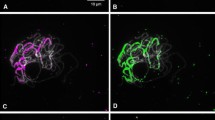Summary
We have characterised the major DNA sequence component of knob heterochromatin in maize, teosinte andTripsacum. Sequence analysis of this DNA gives strong support to the proposal that maize originated by selection of variants in teosinte. In situ hybridization has confirmed that this repeating DNA sequence, which is the major component of maize knob heterochromatin, is also the major component of knobs in teosinte,Zea diploperennis andTripsacum. In Southern blot hybridizations the repeat has a similar basic organization in all taxa;Tripsacum, however, is differentiated from maize and teosinte by a number of sequence features. Maize and teosinte knob heterochromatin are indistinguishable with regard to the distribution of mutations in the 180-bp repeat and the presence and organization of a 202-bp variant sequence. The knob DNA sequence was not detectable in three species ofCoix, an Old World genus of the Maydeae.
Within the repeat unit is a 27-bp region that shows no sequence changes in maize, teosinte orTripsacum. The remainder of the repeat unit has randomly distributed nucleotide changes. The presence of the conserved sequence region suggests that knob DNA may have a functional role in the nucleus.
Similar content being viewed by others
References
Appels R, Gerlach WL, Dennis ES, Swift H, Peacock WJ (1980) Molecular and chromosomal organization of DNA sequences coding for the ribosomal RNAs in cereals. Chromosoma 78:293–311
Appels R, Dennis ES, Smyth DR, Peacock WJ (1981) Two repeated DNA sequences from the heterochromatic regions of rye (Secale cereale) chromosomes. Chromosoma 84:265–277
Beadle GW (1980) The ancestry of corn. Sci Am 242:96–103
Brown AHD, Clegg MT (1983) Analysis of variation in related DNA sequences. In: Weir BS (ed) Statistical analyses of DNA sequences. Marcel Dekker, New York, pp 107–132
Dennis ES, Dunsmuir P, Peacock WJ (1980) Segmental amplification in a satellite DNA: restriction enzyme analysis of the major satellite ofMacropus rufogriseus. Chromosoma 79:179–198
Galinat WC (1978) The inheritance of some traits essential to maize and teosinte. In: Walden DB (ed) Maize breeding and genetics. John Wiley & Sons, New York, pp 93–111
Iltis HH, Doebley FJ, Guzman R, Pazy B (1979)Zea diploperennis (Gramineae): a new teosinte from Mexico. Science 203:186–188
Jain HK (1973) Genetic differentiation of two Himalayan varieties of maize. Ind J Genet Plant Breeding 33:401–415
Kato Yamakake TA (1975) Cytological studies of maize and teosinte in relation to their origin and evolution. Ph. D. thesis, University of Massachusetts, Amherst and Mass Agric Exp Sta Bull 635 (1976)
Longley AE (1937) Morphological characters of teosinte chromosomes. J Agric Res 54:835–862
Longley AE (1941) Chromosome morphology in maize and its relatives. Bot Rev 7:263–289
Mangelsdorf PC (1974) Corn, its origin, evolution and improvement. Harvard University Press, Cambridge, Massachusetts, pp 1–262
Mangelsdorf PC, MacNeish RS, Galinat WC (1964) Domestication of corn. Science 143:538–545
Mangelsdorf PC, Roberts LM, Rogers JS (1981) The probable origin of annual teosinte, Publication 10, The Bussey Institute of Harvard University, Cambridge, Massachusetts
Maxam AM, Gilbert W (1980) Sequencing end-labelled DNA with base specific chemical cleavages. Methods Enzymol 65:499–560
Messing J, Vieira J (1982) A new pair of M13 vectors for selecting either DNA strand of double-digest restriction fragments. Gene 19:269–276
Nirodi N (1955) Studies on Asiatic relatives of maize. Ann Mo Bot Garden 42:103–130
Pasupuleti CV, Galinat WC (1982)Zea diploperennis: 1. Its chromosomes and comparative cytology. J Hered 73:168–172
Peacock WJ, Dennis ES, Rhoades MM, Pryor AJ (1981) Repeated DNA limited to knob heterochromatin in maize. Proc Natl Acad Sci USA 78:4490–4494
Pryor AJ, Faulkner K, Rhoades MM, Peacock WJ (1981) Asynchronous replication of heterochromatin in maize. Proc Natl Acad Sci USA 77:6705–6709
Rhoades MM (1978) Genetic effects of heterochromatin in maize. In: Walden DB (ed) Maize breeding and genetics. John Wiley & Sons, New York, pp 641–672
Sanger F, Nicklen S, Coulson AR (1977) DNA sequencing with chain-terminating inhibitors. Proc Natl Acad Sci USA 74:5463–5476
Southern EM (1975) Long range periodicities in mouse satellite DNA. J Mol Biol 34:51–69
Starlinger P, Saedler H (1976) IS-elements in microorganisms. Curr Top Microbiol Immunol 75:111–124
Truett MA, Jones RS, Potter SS (1981) Unusual structure of the FB family of transposase elements inDrosophila. Cell 24:753–763
Ward EJ (1980) Banding patterns in maize mitotic chromosomes. Can J Genet Cytol 22:61–67
Wilkes HG (1967) Teosinte; the closest relative of maize, Bussey Institute, Harvard University, Cambridge, Massachusetts, pp 1–159
Author information
Authors and Affiliations
Rights and permissions
About this article
Cite this article
Dennis, E.S., Peacock, W.J. Knob heterochromatin homology in maize and its relatives. J Mol Evol 20, 341–350 (1984). https://doi.org/10.1007/BF02104740
Issue Date:
DOI: https://doi.org/10.1007/BF02104740




